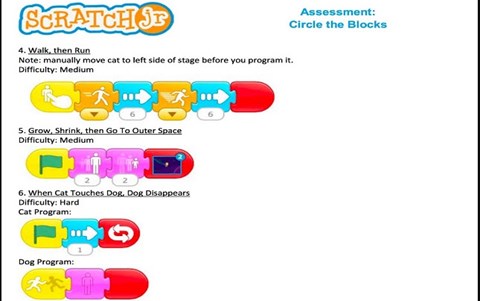ScratchJr Assessment

About this lesson
ScratchJr Assessments is a resource to assess students’ understanding of the programming blocks in the ScratchJr iPad app.
Year band: 1-2, 3-4
Curriculum LinksCurriculum Links
Years F–2
Content Descriptors
Follow, describe and represent a sequence of steps and decisions (algorithms) needed to solve simple problems (ACTDIP004)
Achievement Standards
Design solutions to simple problems using a sequence of steps and decisions.
Years 3–4
Content Descriptors
Define simple problems, and describe and follow a sequence of steps and decisions (algorithms) needed to solve them (ACTDIP010)
Achievement Standards
Plan a sequence of steps (algorithms) to create solutions, including visual programs.
Learning sequence
Description
This assessment section provides two guides that outline how to assess students’ understanding of the programming blocks in the ScratchJr iPad app. The ScratchJr Solve-Its where students watch the videos in the playlist and record their answers on an answer sheet. The other assessment guide involves reverse-engineering, in which students determine what visual programming blocks have been used to create a simple animation (program).
Guidance For Use
This assessment activity can be used after students have been exposed to introductory lessons on how to use the ScratchJr program, the types and functions of the blocks and having had experience in creating simple programs in ScratchJr.
Teachers can collect students’ worksheets and mark correct and incorrect responses. This will help determine if students have an understanding of the correct function and use of the visual programming blocks, ability to identify correct script sequences, ability to correctly determine a sequence of blocks that solve a simple problem (an animation).
Some opportunities for extending or adapting this assessment resource are given below:
- Have students work in pairs or small groups to foster discussion and peer-to-peer learning.
- Instead of using the worksheet, have large cut-outs of the blocks and ask students or teams of students to reconstruct the script.
- For younger students, use this as a whole-class assessment activity, where students, with scaffolding and questioning from the teacher, decide on the appropriate script, or reconstruct the script together. The teacher can direct questions to individuals and invite students to explain why they have made certain decisions.
- Extend this activity by having students create their own script challenges for a peer. Have students provide feedback to one another.
- Teachers could use this framework for one-on-one individual assessment with a student. Teachers can ask students to explain why they selected certain scripts to match the animation, providing teachers with greater insight into misconceptions and student understandings.
- Extend this assessment activity to invite students to reconstruct the code using the ScratchJr App. Allow them the opportunity to test and de-bug their script.
Guidance for Assessment
This assessment guide is great for teachers with all levels of experience, as it essentially involves checking for the presence of certain blocks or circling of certain blocks, between what the student has created and the template. Below we have some information about the key concepts to support you in making assessments and exploring their understanding.
Sequence: Students are asked to construct a sequence of steps (algorithm). They will do this by arranging various blocks in a logical sequence. An algorithm will have a start (e.g. press the green flag) and an end point (red end block). These blocks execute one after the other. Students will test that their code executes in the correct order by following the execution of code and checking the visual animation.
- Are blocks constructed in the correct sequence?
- Do the blocks match their intended goal (e.g. that a character says something or moves a certain way).
- Can students explain what happens in the program by reading through the blocks step-by-step?
- Can students predict the outcome of a sequence of blocks?
Repetition: Although Repetition is not explicitly expected to be taught and assessed in this Year band, students can explore ways that they can make their algorithm more efficient. They do this by identifying patterns in their code (duplicate blocks in a row or duplicate sequences). They can adapt their code by removing multiples of the same blocks and instead changing the number of times a block is executed on the block or by inserting a loop (orange repeat block or the red repeat forever block). Teachers can ask students to circle blocks that are the same or that repeat and look for patterns.
- Look at students’ algorithms and identify if they have changed the number of times a block is executed.
- See if students can reduce multiple blocks that are the same to fewer, but with the same output.
- Ask students to identify patterns in their algorithms.
Branching/Decisions: Decision blocks can be used to tell a computer what to execute based on a decision or condition in the code. In the early years, this can be captured by the ScratchJr ‘triggering blocks’. These blocks include instructions that describe decisions, such as whether an action is to be carried out based on an event occurring (such as tapping the screen, or two characters touching).
- Ask students to explain what happens in their algorithm and how they made certain things happen in their program.
- Point to certain blocks and ask them to explain what will happen if they use it in their algorithm.
- Challenge students with a condition and see if they can make it happen using the blocks.
© 2021 Education Services Australia Ltd, unless otherwise indicated. Creative Commons BY4.0 licence, unless otherwise indicated. ScratchJr is © Developmental Technologies Research Group at Tufts University.